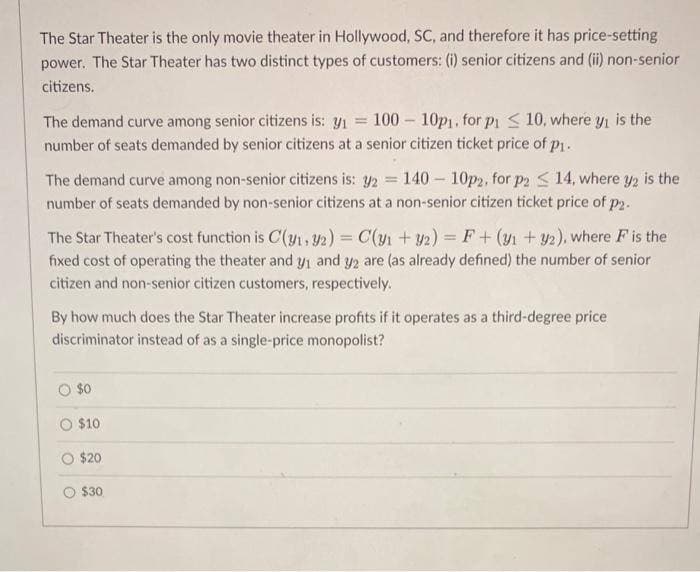The Star Theater is the only movie theater in Hollywood, SC, and therefore it has price-setting power. The Star Theater has two distinct types of customers: (i) senior citizens and (ii) non-senior citizens. The demand curve among senior citizens is: y₁ = 100-10p₁, for p₁ 10, where y₁ is the number of seats demanded by senior citizens at a senior citizen ticket price of p1. The demand curve among non-senior citizens is: y2 = 140 10p2, for p2 ≤ 14, where y2 is the number of seats demanded by non-senior citizens at a non-senior citizen ticket price of p2. The Star Theater's cost function is C(31,92) = C(y1 + y2) = F + (y1 + y2), where F is the fixed cost of operating the theater and y₁ and y2 are (as already defined) the number of senior citizen and non-senior citizen customers, respectively. By how much does the Star Theater increase profits if it operates as a third-degree price discriminator instead of as a single-price monopolist? $0 $10 $20 $30
The Star Theater is the only movie theater in Hollywood, SC, and therefore it has price-setting power. The Star Theater has two distinct types of customers: (i) senior citizens and (ii) non-senior citizens. The demand curve among senior citizens is: y₁ = 100-10p₁, for p₁ 10, where y₁ is the number of seats demanded by senior citizens at a senior citizen ticket price of p1. The demand curve among non-senior citizens is: y2 = 140 10p2, for p2 ≤ 14, where y2 is the number of seats demanded by non-senior citizens at a non-senior citizen ticket price of p2. The Star Theater's cost function is C(31,92) = C(y1 + y2) = F + (y1 + y2), where F is the fixed cost of operating the theater and y₁ and y2 are (as already defined) the number of senior citizen and non-senior citizen customers, respectively. By how much does the Star Theater increase profits if it operates as a third-degree price discriminator instead of as a single-price monopolist? $0 $10 $20 $30
Micro Economics For Today
10th Edition
ISBN:9781337613064
Author:Tucker, Irvin B.
Publisher:Tucker, Irvin B.
Chapter9: Monopoly
Section: Chapter Questions
Problem 20SQ
Related questions
Question

Transcribed Image Text:The Star Theater is the only movie theater in Hollywood, SC, and therefore it has price-setting
power. The Star Theater has two distinct types of customers: (i) senior citizens and (ii) non-senior
citizens.
The demand curve among senior citizens is: y₁ = 100-10p₁, for p₁ 10, where y₁ is the
number of seats demanded by senior citizens at a senior citizen ticket price of p1.
The demand curve among non-senior citizens is: y2 = 140 10p2, for p2 ≤ 14, where y2 is the
number of seats demanded by non-senior citizens at a non-senior citizen ticket price of p2.
The Star Theater's cost function is C(31,92) = C(y1 + y2) = F + (y1 + y2), where F is the
fixed cost of operating the theater and y₁ and y2 are (as already defined) the number of senior
citizen and non-senior citizen customers, respectively.
By how much does the Star Theater increase profits if it operates as a third-degree price
discriminator instead of as a single-price monopolist?
$0
$10
$20
$30
Expert Solution
This question has been solved!
Explore an expertly crafted, step-by-step solution for a thorough understanding of key concepts.
Step by step
Solved in 2 steps

Recommended textbooks for you







Managerial Economics: Applications, Strategies an…
Economics
ISBN:
9781305506381
Author:
James R. McGuigan, R. Charles Moyer, Frederick H.deB. Harris
Publisher:
Cengage Learning